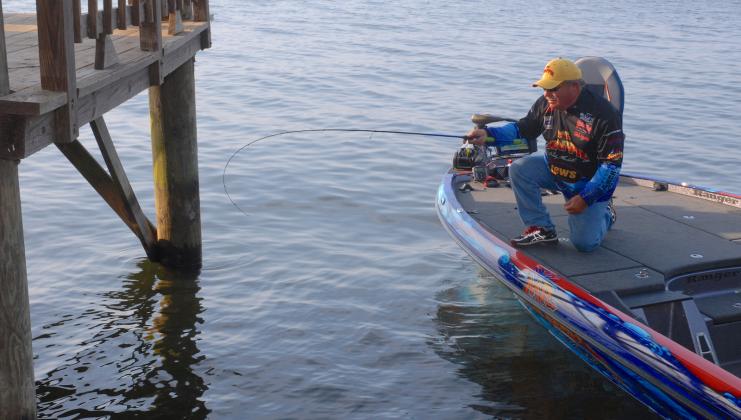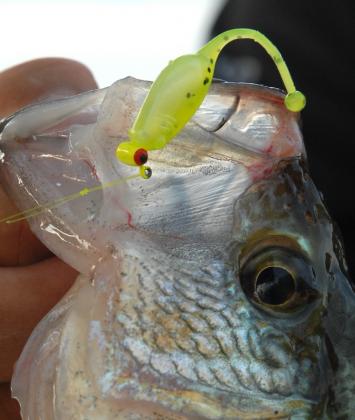Wally Marshall of Westminster is arguably one of the most well-known crappie fishermen in North America. He goes by the nickname “Mr. Crappie,” a fitting moniker he trademarked way back in 1996. Marshall has since helped thousands of anglers learn to catch more of the tasty panfish on lakes around the country using a variety of tactics and baits.
He’s managed a comfortable living doing it, too. Marshall has won several big league crappie tournaments, but his derby winnings are chump change compared to bigger bucks he’s earned from spreading the word about an unsung sport fish and sharing closely guarded secrets to fishing success.
A former plumber, Marshall gets paid to engineer useful gear to make good crappie fishermen even better. His “Mr. Crappie" logo is stamped on dozens products marketed by some of the top outdoor retailers in the country.
Rods, line, hooks, reels, corks, rod holders, fishing seats, crankbaits, tackle boxes, jigs—if a product has anything to do with crappie fishing, Marshall probably has a finger in it.
It's good stuff, too. Marshall designs most of his own products, and he’s got a likable personality and the golden gift of gab for promoting them.
Naturally, Marshall has learned some hard lessons during a lifetime of crappie fishing. One of the toughest dates back to 1989, when he entered a crappie tournament on Lake Wylie in the Carolinas.
It was two years after he won the first crappie tournament ever held in Texas, a Crappiethon USA event on Cedar Creek Lake. Marshall wade fished his way to the winner’s circle at Cedar Creek targeting spawning crappie around shoreline cattails using a long rod jigging technique he calls “Wally-socking.”
There weren’t any cattails to Wally-sock at Lake Wylie, but there were hundreds of boat docks and piers ripe for a technique called “shooting.”
Problem was, Marshall didn’t know much about the deadly fishing tactic that eastern locals relied on to sling-shot their jigs deep into the shady bowels of the shoreline structures, where schools of hungry crappie like to gather.
“I’d heard about dock shooting, but I didn’t know how to do it,” Marshall recalled. “I drove 1,000 miles to Lake Wylie thinking I was going to compete out of a float tube. That tournament was downright ugly. I don’t remember where I finished in the standings, but it was probably dead last.”
Marshall didn’t dwell on the thrashing for long. Instead, he brought the experience back to Texas and perfected the technique in short order.
Dock shooting is now a speciality tactic Marshall relies on to catch crappie from spring through fall on just about any lake with boat docks, slips and piers. Cedar Creek, Palestine, Tawakoni, Fork, Conroe, Texoma, Athens, Toledo Bend and Bridgeport are among the Texas lakes where he’s had the most success.
“There doesn’t have to be bunch of docks for it to work, either,” he said. “An isolated dock can be money if it’s in the right place.”
Bait fish such as minnows, shad and small perch gravitate to docks to feed, seek shelter and hide from larger predators. Like bass, crappie take advantage of the shade to ambush unsuspecting forage. The fish also are attracted to the cooler water beneath the canopy, and the dock shooting tactic is ideal for getting at them.
LEARNING TO SHOOT
Marshall says the magic is built around the presentation of the bait, usually a 1/16- or 1/32-ounce jig, paired with a medium/light spinning outfit and high visibility monofilament line in 4- to 6-pound test.
Done correctly, Marshall says shooting will catapult the jig at a low angle, parallel to the water, with enough velocity that it will sail far beneath the dock or whatever you’re aiming at.
Performing the technique is a simple, multi-step process:
1.) Release enough line so the jig falls between the bottom rod guide and the reel. Trap the line against the rod with the index finger on your rod hand. Grip the jig head firmly between the index finger and thumb on your free hand. Make sure the exposed hook is turned downward.
2.) Point the rod tip at the target dock with the line and jig parallel to the water. This will cause the rod to bend or load backwards, sort of like a bow and arrow. You might want to sit or kneel to get a lower angle.
3.) Release the jig and trapped line simultaneously. This causes the loaded rod tip to spring forward and sling-shot the bait towards the target.
Marshall claims he can shoot a 1/16-ounce Slab Daddy or Shad Pole jig about 60 feet with the right outfit.
“It enables you to put a jig into the coffin corners—the deepest, darkest places under that dock that are impossible to get to with a conventional cast,” he said. “Plus, it allows you to get a bait beneath a dock without getting so close that might spook fish that are hanging closer to the outside edge.”
PRACTICE MAKES PERFECT
Marshall says anyone can learn to shoot docks effectively with practice and persistence. Beginners can learn in their yard or driveway by sitting in a lawn chair and using a sawhorse positioned 15-20 feet away to simulate the dock.
He suggests practicing with 1/16-ounce lead weight instead of a jig. Practice until you can consistently shoot the weight under the sawhorse and varied distances.
Having the proper equipment helps flatten the learning curve. A sensitive rod is a key component.
Marshall’s favorite is a 7-foot, medium/light action spinning model he helped design specifically for shooting for Lew’s. Fittingly, the rod is called the “Speed Shooter.” It’s made from sensitive IM8 graphite with a fast-tip action tip. The rod sells for around $45.
MAKING MEMORIES
Not surprisingly, Marshall has caught a boat load of crappie shooting his jigs into places where the sun doesn’t shine. One of his most memorable dock shooting experiences occurred during a team crappie tournament on the Harris Chain of Lakes in Florida.
Marshall had located a large octagon-shaped dock that was loaded with crappie. The dock was built far enough above the water that his boat would partially fit beneath it.
Surprisingly, there was a wedding underway on the dock when Marshall and his partner arrived on the first day of the tournament.
“I’ll never forget it,” said Marshall. “We were up under that dock sloshing around and catching one fish after another with a wedding going above us. One the guys at the wedding leaned over the hand rail and said ‘man, this is better than watching TV.’”
—Matt Williams is a freelance writer based in Nacogdoches. He can be reached by e-mail, mattwillwrite4u@yahoo.com.




